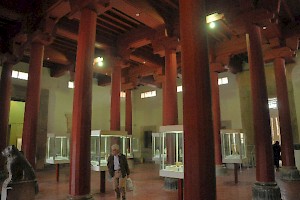Persepolis, Queen's Quarters
Persepolis (Old Persian Pârsa, modern Takht-e Jamshid): Greek name of one of the capitals of the ancient Achaemenid Empire, founded by king Darius the Great (r.522-486 BCE). There were several satellite sites, Naqš-e Rustam and Takht-e Rustam.
Queen's Quarters

The "Queen's Quarters" or "harem" is the name of several buildings in the southeastern part of the terrace of Persepolis. One of these buildings has been more or less reconstructed and is now in use as a museum, and as the office of the Persepolis archaeological complex.
The name "harem" is better avoided. It should be stressed that Achaemenid harems never existed and are in fact an invention by western scholars. Europeans knew about the harem of the Ottoman sultan, read about polygamous Persians, and projected their own ideas on the ancient Near East. Stories about the great king's 360 wives are nothing but Greek sexual fantasies; from the Persepolis Fortification Tablets, we learn that rulers like Darius had perhaps four wives.

The decoration of the Queen's Quarters is not very different from the rooms of the king - reliefs of royal warriors fighting against lions and so on.
A famous inscription (known as the "harem inscription" or XPf) was found in the Queen's Quarters. It deals with Xerxes' accession to his father's throne and mentions that there were rival candidates:
My father Darius had other sons, but - thus was Ahuramazda's desire - my father Darius made me the largest [mathišta] after himself. When my father Darius went away from the throne, by the grace of Ahuramazda I became king on my father's throne.
One copy is in the Archaeological Museum of Tehran. Another copy of the same text is in the museum of Persepolis.



